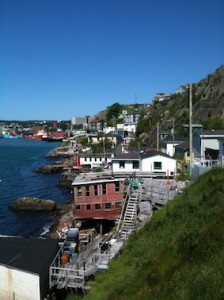To tackle the question about whether we are planning or organizing our cities, it is necessary to first look at the purpose of cities.
The large, evolutionary purpose of cities is to create a habitat in which we can generate new ways of thinking, making and doing new things. We build the very habitats we need in the form of cities. Our cities are our nests. Within this large purpose, there are stages of purpose of settlements and cities. At each stage, we are driven to more than merely survive: we wish to thrive and move on to a next stage. This takes place as we constantly look for new work (new ways of thinking, making and doing new things) in relationship with our habitat (physical and social). At each stage, we build the nest we need.
It is time now to again build the nest that we need. In order to do that, we need to discern the pattern that can be seen so far.
St. John’s

In North America, St. John’s, Newfoundland is a perfect place to marvel at how human settlement changes as the purpose of the settlement changes over time. In his opening remarks at the 2011 Canadian Institute of Planners conference in St. John’s, Mayor Dennis O’Keefe invited conference participants to explore and pay particular attention to the ‘unplanned city’. He made this invitation in jest, for you can’t miss the unplanned part of this city. There is a crazy mix of buildings and roads, houses perched on rocky slopes hovering perilously over the water. The steep hills that every engineer I have worked with – if asked for approval – would scream rejection. Streets everywhere connecting and ending with no discernable pattern. Streets impossibly skinny, too short, too curvy. Today, much of this shape remains as St. John’s unplanned city.
This unplanned city is mesmerizing. The word unplanned immediately conjures in my mind some form of ‘accidental’ or ‘inadvertent’ city, but St. John’s is not an unintentional settlement. It was very purposeful, and that purpose guided the very shape of St. John’s. In fact, the purpose of St. John’s as a settlement has shifted over time, with each step in its evolution leaving its mark.
Mayor’ O’Keefe’s jest might have slipped by me were it not for two things that startled me while exploring the unplanned city. First, the St. John’s Port Authority is over five hundred years old. Second, seeing a map describing land ownership with the words, “from the high water mark to the back of the fish flakes.” The life conditions of historic St. John’s are radically different from what I know on the Canadian prairies. I am not used to imagining European settlers’ lives in North America over 500 years ago. While the words, “from the high water mark” are familiar, the words, “to the back of the fish flakes” belong to a way of life in another era, wholly unfamiliar to my life on the Canadian prairies in Edmonton.
Life Conditions
I see the evolving purpose – and shape – of cities from the vantage point of their life conditions. With the words ‘life conditions’, I am drawing on Clare Grave’s work on evolutionary value systems, and the notion that humans are driven by the dynamic interaction between our internal states and our external worlds. Our life conditions, our external worlds, are our habitat:
- The historic times we live in (the era)
- The geographic place (the physical conditions)
- The challenges we face to exist (priorities, survival issues, threats to safety); and
- The social circumstances in which we find ourselves (status, lineage, political systems).
St. John’s reveals clear examples of how life conditions have an impact on the purpose of a city, and the shape a city ultimately takes. And as life conditions change, the city’s shape evolves as needed.
Sources –
Beck, Don Edward and Cowan, Christopher C., Spiral Dynamics: Mastering Values, Leadership, and Change, Blackwell Publishing Ltd., Oxford (2006), particularly pages 52-56.
Hamilton, Marilyn, Integral City: Evolutionary Intelligences for the Human Hive, New Society Publishers Inc., Gabriola Island (2008)
Sanders, Beth, “From the High Water Mark to the Back of the Fish Flakes: The Evolutionary Purpose of Cities,” Vol 51, No. 4, p 26-31, Plan Canada. Print publication of the Canadian Institute of Planners.